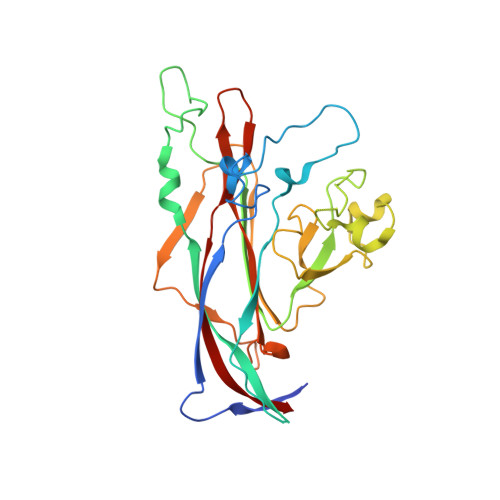Structures of Merkel Cell Polyomavirus VP1 Complexes Define a Sialic Acid Binding Site Required for Infection.
Neu, U., Hengel, H., Blaum, B.S., Schowalter, R.M., Macejak, D., Gilbert, M., Wakarchuk, W.W., Imamura, A., Ando, H., Kiso, M., Arnberg, N., Garcea, R.L., Peters, T., Buck, C.B., Stehle, T.(2012) PLoS Pathog 8: e1002738-e1002738
- PubMed: 22910713
- DOI: https://doi.org/10.1371/journal.ppat.1002738
- Primary Citation of Related Structures:
4FMG, 4FMH, 4FMI, 4FMJ - PubMed Abstract:
The recently discovered human Merkel cell polyomavirus (MCPyV or MCV) causes the aggressive Merkel cell carcinoma (MCC) in the skin of immunocompromised individuals. Conflicting reports suggest that cellular glycans containing sialic acid (Neu5Ac) may play a role in MCPyV infectious entry. To address this question, we solved X-ray structures of the MCPyV major capsid protein VP1 both alone and in complex with several sialylated oligosaccharides. A shallow binding site on the apical surface of the VP1 capsomer recognizes the disaccharide Neu5Ac-α2,3-Gal through a complex network of interactions. MCPyV engages Neu5Ac in an orientation and with contacts that differ markedly from those observed in other polyomavirus complexes with sialylated receptors. Mutations in the Neu5Ac binding site abolish MCPyV infection, highlighting the relevance of the Neu5Ac interaction for MCPyV entry. Our study thus provides a powerful platform for the development of MCPyV-specific vaccines and antivirals. Interestingly, engagement of sialic acid does not interfere with initial attachment of MCPyV to cells, consistent with a previous proposal that attachment is mediated by a class of non-sialylated carbohydrates called glycosaminoglycans. Our results therefore suggest a model in which sialylated glycans serve as secondary, post-attachment co-receptors during MCPyV infectious entry. Since cell-surface glycans typically serve as primary attachment receptors for many viruses, we identify here a new role for glycans in mediating, and perhaps even modulating, post-attachment entry processes.
Organizational Affiliation:
Interfaculty Institute of Biochemistry, University of Tuebingen, Tuebingen, Germany.

















